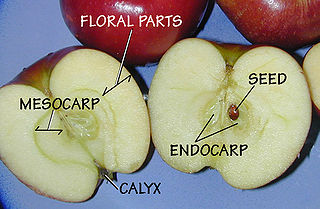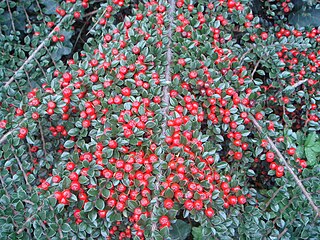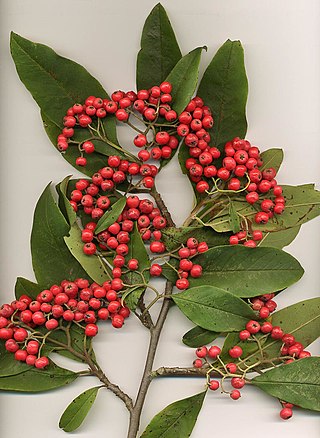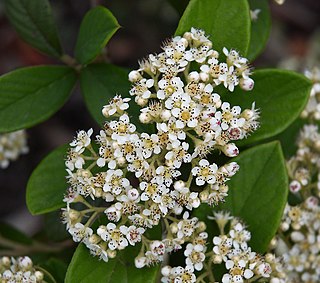
Rosaceae, the rose family, is a medium-sized family of flowering plants that includes 4,828 known species in 91 genera.

The MaloideaeC.Weber was the apple subfamily, a grouping used by some taxonomists within the rose family, Rosaceae. Recent molecular phylogenetic evidence has shown that the traditional Spiraeoideae and Amygdaloideae form part of the same clade as the traditional Maloideae, and the correct name for this group is Amygdaloideae. Earlier circumscriptions of Maloideae are more-or-less equivalent to subtribe Malinae or to tribe Maleae. The group includes a number of plants bearing commercially important fruits, such as apples and pears, while others are cultivated as ornamentals.

In botany, a pome is a type of fruit produced by flowering plants in the subtribe Malinae of the family Rosaceae. Pome fruits consist of a central "core" containing multiple small seeds, which is enveloped by a tough membrane and surrounded by an edible layer of flesh. Pome fruit trees are deciduous, and undergo a dormant winter period that requires cold temperatures to break dormancy in spring. Well-known pomes include the apple, pear, and quince.

Heteromeles arbutifolia, commonly known as toyon, is a common perennial shrub native to extreme southwest Oregon, California, and the Baja California Peninsula. It is the sole species in the genus Heteromeles.

Photinia is a genus of about 30 species of small trees and large shrubs, but the taxonomy has recently varied greatly, with the genera Heteromeles, Stranvaesia and Aronia sometimes included in Photinia.

Cotoneaster franchetii is a species of Cotoneaster native to southwestern China, in the provinces of Guizhou, Sichuan, Tibet, and Yunnan, and also in adjacent northern Myanmar and northern Thailand.

Sambucus nigra is a species complex of flowering plants in the family Adoxaceae native to most of Europe. Common names include elder, elderberry, black elder, European elder, European elderberry, and European black elderberry. It grows in a variety of conditions including both wet and dry fertile soils, primarily in sunny locations. The plant is widely grown as an ornamental shrub or small tree. Both the flowers and the berries have a long tradition of culinary use, primarily for cordial and wine.

Pyracantha angustifolia is a species of shrub in the rose family known by the common names narrowleaf firethorn, slender firethorn and woolly firethorn. The flowers are white and produce small round pomes and can be orange to red in color. These fruits are astringent and bitter, making them inedible for humans, but they are a food source for birds. The leaves, fruit and seeds contain hydrogen cyanide, the source of the bitter taste. The stems and branches have sharp spines. This shrub is cultivated and grown in yards and gardens as an ornamental plant. It can be used to make hedges for home security. This species is native to China but has been introduced to North America and Australia. It is an invasive species in Hawaii and in other areas.

Pyracantha coccinea, the scarlet firethorn is the European species of firethorn or red firethorn that has been cultivated in gardens since the late 16th century. The tree has small white flowers. It produces small, bright red berries. Its leaves are slightly toothed and grow opposite to one another. The fruit is bitter and astringent, making it inedible when raw. The fruit can be cooked to make jellies, jams, sauces and marmalade. It ranges from southern Europe to western Asia. It has been introduced to North America and cultivated there as an ornamental plant since the 18th century.
Pyracantha atalantioides is a species of Firethorn shrub.

Pyracantha crenatoserrata, commonly known as Chinese firethorn or Yunnan firethorn, is a species of firethorn. It is a short shrub. It is cultivated for its decorative bright red pome fruit. The flowers are white. It survives in warm climates. It cannot tolerate frost, but it can withstand drought. This species originates from central China.

Pyracantha crenulata, the Nepalese firethorn, Nepal firethorn or Himalayan firethorn, is a species of firethorn. It is cultivated as an ornamental plant. The leaves are used to make herbal tea. The wood can be used to make walking sticks. The pome fruit is orange-red and are food for birds. It is locally named as Ghingharu(घिंगारू) in Kumaon region of Uttarakhand, India.
Pyracantha rogersiana, the Asian firethorn, is a species of flowering plant in the family Rosaceae, native to western China. Growing to 4 metres (13 ft) tall and broad, it is an evergreen shrub with glossy, narrow leaves, and masses of white flowers followed by small yellow berries 8 mm in diameter. It is grown in gardens, yards, and parks, where it can be used as hedging, wall cover, or in a mixed shrub border. The cultivar 'Flava' has gained the Royal Horticultural Society's Award of Garden Merit.

The Maleae are the apple tribe in the rose family, Rosaceae. The group includes a number of plants bearing commercially important fruits, such as apples and pears, while others are cultivated as ornamentals. Older taxonomies separated some of this group as tribe Crataegeae, as the Cydonia group, or some genera were placed in family Quillajaceae.

Malinae is the name for the apple subtribe in the rose family, Rosaceae. This name is required by the International Code of Nomenclature for algae, fungi, and plants, which came into force in 2011 for any group at the subtribe rank that includes the genus Malus but not either of the genera Rosa or Amygdalus. The group includes a number of plants bearing commercially important fruits, such as apples and pears, while others are cultivated as ornamentals.

Cotoneaster adpressus, commonly known as creeping cotoneaster, is a species of flowering plant in the genus Cotoneaster of the family Rosaceae, native to western China. It is a prostrate, dense, deciduous shrub growing to 2 metres wide. It has masses of tiny rounded leaves, with white flowers followed by bright scarlet berries. It is cultivated as groundcover in gardens in temperate regions.

Cotoneaster atropurpureus, the purple-flowered cotoneaster, is a species of flowering plant in the genus Cotoneaster of the family Rosaceae, native to the Hubei province of China. It is a prostrate, deciduous shrub growing to 2.5 metres wide. It can be used as groundcover or trained to ascend up a wall or other support. Its fan-shaped, arching branches bear small, rounded, glossy green leaves turning purple in autumn. Red/black flowers are followed by small, globose, scarlet fruits (pomes).

Cotoneaster frigidus, the tree cotoneaster, is a species of flowering plant in the genus Cotoneaster of the family Rosaceae, native to the Himalayas. It is a deciduous tree or shrub growing to 10 metres (33 ft). White flowers are followed by masses of small, globose, red fruits (pomes) in autumn, persisting into winter if not eaten by birds.

Cotoneaster lacteus, the late cotoneaster or milkflower cotoneaster, is a species of flowering plant in the genus Cotoneaster of the family Rosaceae, native to the Yunnan Province of China. It is a large evergreen shrub growing to 4 m (13 ft) tall and wide. Clusters of white flowers are followed by masses of small, globose, red fruits (pomes) in autumn. Unusually for this genus, the fruits are avoided by birds, hence garden escapes are rare, and the fruit persists on the plant throughout the winter.

















